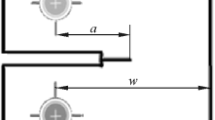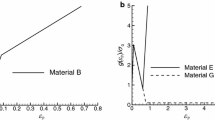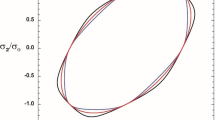Abstract
In this paper we demonstrate that a plastically deformed zone around a stressed crack tip can be, mechanically, identified with an inclusion of transformation strain by means of Eshelby equivalent inclusion method. Thus, the shielding effect of the plastic zone can be quantitatively evaluated by the present transformation toughening theory. A closed-form solution to determine the change in the stress intensity factor induced by the plastic zone is given both for plane stress and plane strain mode I cracks under small-scale yielding conditions. By using the present solution, the effects of the strain-hardening behavior of the material, the plane stress and plane strain states and the T-stress on the crack-tip shielding effects are identified.
Similar content being viewed by others
References
Ayatollahi MR, Pavier MJ, Smith DJ (2002) Mode I cracks subjected to large T-stresses. Int J Fract 117: 159–174
Barenblatt GI (1962) The mathematical theory of equilibrium cracks in brittle fracture. Adv Appl Mech 5: 55–129
Becker W, Gross D (1968) About the Dugdale crack under mixed-mode loading. Int J Fract 37: 163–171
Betagon C, Hancock JW (1991) Two parameter characterization of elastic-plastic crack-tip fields. J Appl Mech 58: 104–110
Bonfoh N, Lipinski P, Carmasol A, Tiem S (2004) Micromechanical modeling of ductile damage of polycrystalline materials with heterogeneous particles. Int J Plast 20: 85–106
Budiansky B, Hutchinson JW, Lambropoulos JC (1983) Continuum theory of dilatant transformation toughening in ceramics. Int J Solids Struct 19: 337–355
Ding F, Feng M, Jiang Y (2007) Modeling of fatigue crack growth from a notch. Int J Plast 23: 1167–1188
Dugdale DS (1960) Yielding of steel sheets containing slits. J Mech Phys Solids 8: 100–108
Eshelby JD (1957) The determination of the elastic fields of an ellipsoidal inclusion, and related problem. In: Proceeding of the Royal Society, Vol. 241. London, Series A, 376-396
Evans AG, Faber KT (1983) Crack growth resistance of microcracking brittle materials. J Am Ceram Soc 67: 255–260
Gao X, Dodds RH Jr (2001) An engineering approach to assess constraint effect on cleavage fracture toughness. Eng Fract Mech 68: 263–283
Hillerborg A (1985) The theoretical basis of a method to determine the fracture energy G F of concrete. Mater Struct 18: 291–296
Hutchinson JW (1968) Plastic stress and strain fields at a crack tip. J Mech Phys Solids 16: 337–347
Hutchinson JW (1987) Crack tip shielding by micracracking in brittle solids. Acta Metall 35: 1605–1619
Ippolito M, Mattoni A, Colombo L, Cleri F (2005) Fracture toughness of nanostructured silicon carbide. Appl Phys Lett 87: 141912
Ippolito M, Mattoni A, Colombo L, Pugno (2006) Role of lattice discreteness on brittle fracture: atomistic simulations versus analytical models. Phys Rev B 73: 104111
Irwin GR (1960) Plastic zone near a crack and fracture toughness. Prov Seventh Sagomore Ordnance Mater Res Conf IV: 63–78
Jiang Y, Kurath P (1996) Characteristics of the Armstrong–Frederick type plasticity models. Int J Plast 12: 387–415
Jiang Y, Feng M, Ding F (2005) A reexamination of plasticity-induced crack closure in fatigue crack propagation. Int J Plast 21: 1720–1740
Johoson WC, Earmme YY, Lee JK (1980) Approximation of the strain field associated with an inhomegeneous precipitate. J Appl Mech 47: 775–780
Kang KJ, Beom HG (2000) Plastic zone size near the crack tip in a constrained ductile layer under mixed mode loading. Eng Fract Mech 66: 257–268
Khan SMA, Khraisheh MK (2004) A new criterion for mixed mode fracture initiation based on the crack tip plastic core region. Int J Plast 20: 55–84
Lambropoulous JC (1986) Shear, shape and orientation effects in transformation toughening in ceramics. Int J Solids Struct 22: 1083–1106
Larsson SG, Carlsson AJ (1973) Influence of non-singular stress terms and specimen geometry on small-scale yielding at crack-tip in elastic-plastic materials. J Mech Phys Solids 21: 447–473
Li R, Chudnovsky A (1993) Energy analysis of crack interaction with an elastic inclusion. Int J Fract 63: 247–261
Li Z, Chen Q (2002) Crack-inclusion for mode I crack analyzed by Eshelby equivalent inclusion method. Int J Fract 118: 29–40
Li Z, Duan J (2002) The effect of a plastically deformed zone near crack tip on the stress intensity factors. Int J Fract 117: L29–L34
Li Z, Yang L (2002) The application of the Eshelby equivalent inclusion method for unifying modulus and transformation toughening. Int J Solids Struct 39: 5225–5240
Li Z, Yang L (2004) The near-tip stress intensity factor for a crack partially penetrating an inclusion. J Appl Mech 71: 465–469
Li Z, Zhao Y, Schmauder S (1993) A cohesion model of microcrack toughening. Eng Fract Mech 44: 257–265
Li Z, Yang L, Li S, Sun J (2007) The stress intensity factors for a short crack partially penetrating an inclusion of arbitrary shape. Int J Fruct 148: 243–250
Lipkin DM, ClarKe DR, Beltz GE (1996) A strain gradient model of cleavage fracture in plastically deforming materials. Acta Mater 44: 4051–4058
McClung RC (1991) Crack closure and plastic zone sizes in fatigue. Fatigue Fract Eng Mater Struct 14: 455–468
McMeeking RM (1977) Finite deformation analysis of crack-tip opening in elastic-plastic materials and implication for fracture. J Mech Phys Solids 25:357–381
Moschobidis ZA, Mura T (1975) Two ellipsoidal inhomegeneities by the equivalent inclusion method. J Appl Mech 42: 847–852
Mura T (1987) Micromechanics of defects in solids. Second Revised Edition. Martinus Nijhoff Publishers, Dordrecht
Neimitz A (2004) Modification of Dugdale model to include the work hardening and in and out-of-plane constraints. Eng Fract Mech 71: 1585–1600
O’Dowd NP, Shih CF (1992) Family of crack-tip fields characterized by a triaxiality parameter-II. Fracture applications. J Mech Phys Solids 40: 939–963
Panasyuk VV, Sayruk MP (1992) Plastic strip model in elastic-plastic problems of fracture mechanics. Adv Mech 15: 123–147
Pandey AB, Majumdar BS, Miracle DB (1998) Effects of thickness and precracking on the fracture toughness of particle-reinforced Al-alloy composites. Metall Mater Trans 29: 1237–1243
Park HB, Kim KM, Lee BW (1996) Plastic zone size in fatigue cracking. Int J Vessel Pip 68: 279–285
Rice JR (1974) Limitations to the small scale yielding approximation for crack tip plasticity. J Mech Phys Solids 22: 17–26
Rice JR, Johnson MA (1970) Inelastic behavior of solids. Kanninen MF, Adler WF, Rosenfield AR, Jaffee RI (eds) McGraw-Hill, New York, p 641
Rice JR, Rosengren GF (1968) Plane strain deformation near a crack tip in a power-law hardening material. J Mech Phys Solids 16: 1–12
Robert H, Dodds JR, Anderson Ted L, Kirk Mark T (1991) A framework to correlate a/w ratio effects on elastic-plastic fracture toughness (J c ). Int J Fract 48: 1–22
Sun X, Li H, Chang C (1994) Measurement and research on plane stress fracture toughness K c . Aerosp Mater Technol 2: 53–56 (in Chinese)
Suo Z, Shih CF, Varias AG (1993) A theory for cleavage cracking in the presence of plastic flow. Acta Metall Mater 41: 151–1557
Taya M, Chou TW (1981) On two kinds ellipsoidal inhomegeneities in an infinite elastic body: an application to a hybrid composites. Int J Solids Struct 17: 553–563
Tijssens MGA, Vander Gissen E, Sluys LJ (2000) Modeling of crazing using a cohesive surface methodology. Mech Mater 32: 19–35
Wang X (2003) Elastic T-stress solutions for semi-elliptical surface cracks in finite thickness plates. Eng Fract Mech 70: 731–756
Weertman J (1996) Dislocation based fracture mechanics. Word Scientific, Singapore
Wei Y, Xu G (2005) A multiscale model for the ductile fracture of crystalline materials. Int J Plast 21: 2123–2149
Withers DJ, Stobbs WM, Pederson OB (1989) The application of the Eshelby method of internal stress determination to short fibre metal matrix composites. Acta Mettall 37: 3061–3084
Yang L, Chen Q, Li Z (2004) Crack-inclusion interaction for mode II crack analyzed by Eshelby equivalent inclusion method. Eng Fract Mech 71: 1421–1433
Zhou C, Li Z (2007) The effect of T-stress on crack-inclusion interaction under mode I loading. Mech Res Commun 34: 283–288
Author information
Authors and Affiliations
Corresponding author
Additional information
An erratum to this article is available at http://dx.doi.org/10.1007/s10704-011-9618-6.
Rights and permissions
About this article
Cite this article
Zhu, P., Yang, L., Li, Z. et al. The shielding effects of the crack-tip plastic zone. Int J Fract 161, 131–139 (2010). https://doi.org/10.1007/s10704-009-9435-3
Received:
Accepted:
Published:
Issue Date:
DOI: https://doi.org/10.1007/s10704-009-9435-3




